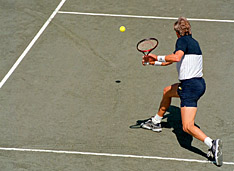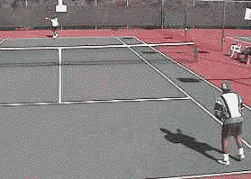|
TennisOne Lessons
Pattern Play, Part 6:Chip and Charge and Put on the Pressure
By Monty Basnyat Are you the super competitive type? When you step on the court, do you think in terms of intimidation, domination, total destruction? Donít get me wrong, I'm not talking about unsportsman like behavior here. Nobody wants to confuse the gentlemanly sport of Tennis with loan sharking. What I'm referring to is exerting steady pressure on opponents, mentally stressing them with aggressive play in order to gain a competitive advantage.
There are many ways to apply pressure; Agassi crushes huge returns and takes the ball early. Sampras uses a booming serve and deadly volleys. For my money, I find rushing the net the best way to turn up the heat. Besides robbing opponents of recovery and set up time, it forces them to make accurate passing shots under pressure. Not an easy thing to do. Chip and ChargeOne of the more effective tactics is to chip and charge on the second serve. Doing so effectively, puts added pressure on an opponent's first serve and creates doubt and tension about the second. The more you come in the more tension you create. Invariably, opponents
will go for tougher passes and bigger serves. This strained thought
pattern along with your dominating presence at the net can cause an
opponent to crack, perpetuating a downward spiral and providing you with
an opportunity to take control of the match. Court PositioningThe key to attacking
the net is court
positioning and the ability to open up the court. In the photo, Borg
is The optimum places to return the ball are down the line or to an opponent's weaker side. The ball travels less distance when struck down the line and you have less distance to travel to be in the optimum volleying position by the time your opponent attempts to pass. Keep the ball low by slicing the return when possible. Topspin balls tend to sit up making it easier for an opponent to hit a passing shot. You Have the Advantage
For the most part, chipping and charging on the second serve is the percentage play. Doing it early and often in the match can set the tone through out and keep the server off balance. However, like every patterned tactic, mix it up, to keep your opponent guessing. Try this tactic on big
points. Whether you win or lose the point, you still gain an advantage. You win the point:
You loose the point:
Who do you Chip and Charge Against?For the most part, against everyone! I have not watched, coached, or played against a single player, who can stay calm and cool under pressure at all times.
To be a good net rusher, whether chipping and charging, serving and volleying or just approaching, you must have the correct mind set. Do not stray from the tactic because you get passed a few times. Think about the big picture. Be persistent, have a short memory, and on the next big point, your opponent may start feeling the tension. Then it's your game I guarantee it. Put this thought pattern inside your opponents head and sooner or later you are going to get the break. |
|
Last Updated 9/1/98. To contact us, please email to: webmaster@tennisone.com TennisONE is a registered trademark of TennisONE and SportsWeb ONE; Copyright 1995. All rights reserved. |
|

 positioned well inside the baseline. This allows
him to take the ball earlier and places him closer to the net after the
return.
Consequently, his opponent has less time to get ready after making his
shot.
positioned well inside the baseline. This allows
him to take the ball earlier and places him closer to the net after the
return.
Consequently, his opponent has less time to get ready after making his
shot.